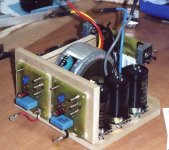Perhaps
You could just be right...
Perhaps the phenomena in question has something to do with the relationship of the inductance of the secondary - the resistance from the secondary to the capacitors - the capacitance - and the waveform ??
You could just be right...
Found it
After listening a couple of days and re-connect one 15,000uf to each supply rail. The result is much better now, everything is balance;
3 X 15000uf per rail; sound strangled, max out bass
2 X 15000uf per rail; balanced sound
1 X 15000uf per rail; excelent dynamic, but thin sounding
All above bias Iq at 4A for Class A mono blocks
Chris
After listening a couple of days and re-connect one 15,000uf to each supply rail. The result is much better now, everything is balance;
3 X 15000uf per rail; sound strangled, max out bass
2 X 15000uf per rail; balanced sound
1 X 15000uf per rail; excelent dynamic, but thin sounding
All above bias Iq at 4A for Class A mono blocks
Chris
Attachments
regulators and transient response....
I was going to use a regulator on my project, but my teacher talked me out of it. He said that it results in poorer transient response. Is this true?
I was going to use a regulator on my project, but my teacher talked me out of it. He said that it results in poorer transient response. Is this true?
a regulator has to sense
the error voltage and then respond to it -- this takes time and compensation.
the error voltage and then respond to it -- this takes time and compensation.
Petter said:This is turning into a perfect thread (order of replies):
1. Technical issues
2. Economic issues
3. Personal issues/interpretations
If all DIYaudio threads were like this, it would be awesome!
Petter
...all we need now is an argument over copyright violations.

- Status
- Not open for further replies.
